+ Open data
Open data
- Basic information
Basic information
| Entry | Database: PDB / ID: 7rua | ||||||||||||||||||
|---|---|---|---|---|---|---|---|---|---|---|---|---|---|---|---|---|---|---|---|
| Title | Metazoan pre-targeting GET complex (cBUGG-out) | ||||||||||||||||||
 Components Components |
| ||||||||||||||||||
 Keywords Keywords | CHAPERONE / ATPase / complex / membrane protein chaperone | ||||||||||||||||||
| Function / homology |  Function and homology information Function and homology informationBAT3 complex / immune response-activating cell surface receptor signaling pathway / GET complex / maintenance of unfolded protein / ubiquitin-like protein transferase activity / tail-anchored membrane protein insertion into ER membrane / positive regulation of ERAD pathway / cytoplasmic sequestering of protein / Hydrolases; Acting on acid anhydrides / synaptonemal complex assembly ...BAT3 complex / immune response-activating cell surface receptor signaling pathway / GET complex / maintenance of unfolded protein / ubiquitin-like protein transferase activity / tail-anchored membrane protein insertion into ER membrane / positive regulation of ERAD pathway / cytoplasmic sequestering of protein / Hydrolases; Acting on acid anhydrides / synaptonemal complex assembly / protein insertion into ER membrane / post-translational protein targeting to endoplasmic reticulum membrane / misfolded protein binding / internal peptidyl-lysine acetylation / endoplasmic reticulum stress-induced pre-emptive quality control / natural killer cell activation / Insertion of tail-anchored proteins into the endoplasmic reticulum membrane / proteasome binding / ubiquitin-specific protease binding / regulation of embryonic development / polyubiquitin modification-dependent protein binding / intrinsic apoptotic signaling pathway in response to endoplasmic reticulum stress / intrinsic apoptotic signaling pathway in response to DNA damage by p53 class mediator / proteasomal protein catabolic process / ERAD pathway / negative regulation of proteasomal ubiquitin-dependent protein catabolic process / synapse assembly / Hsp70 protein binding / molecular function activator activity / kidney development / negative regulation of proteolysis / lung development / regulation of protein stability / brain development / protein modification process / ribosome binding / chromatin organization / chromosome / protein-folding chaperone binding / ubiquitin-dependent protein catabolic process / spermatogenesis / proteasome-mediated ubiquitin-dependent protein catabolic process / molecular adaptor activity / cell differentiation / protein stabilization / intracellular membrane-bounded organelle / signaling receptor binding / ubiquitin protein ligase binding / negative regulation of apoptotic process / nucleolus / apoptotic process / ATP hydrolysis activity / extracellular exosome / nucleoplasm / ATP binding / identical protein binding / membrane / nucleus / metal ion binding / cytosol / cytoplasm Similarity search - Function | ||||||||||||||||||
| Biological species |   Homo sapiens (human) Homo sapiens (human) | ||||||||||||||||||
| Method | ELECTRON MICROSCOPY / single particle reconstruction / cryo EM / Resolution: 3.4 Å | ||||||||||||||||||
 Authors Authors | Keszei, A.F.A. / Yip, M.C.J. / Shao, S. | ||||||||||||||||||
| Funding support |  United States, 5items United States, 5items
| ||||||||||||||||||
 Citation Citation |  Journal: Nat Struct Mol Biol / Year: 2021 Journal: Nat Struct Mol Biol / Year: 2021Title: Structural insights into metazoan pretargeting GET complexes. Authors: Alexander F A Keszei / Matthew C J Yip / Ta-Chien Hsieh / Sichen Shao /  Abstract: Close coordination between chaperones is essential for protein biosynthesis, including the delivery of tail-anchored (TA) proteins containing a single C-terminal transmembrane domain to the ...Close coordination between chaperones is essential for protein biosynthesis, including the delivery of tail-anchored (TA) proteins containing a single C-terminal transmembrane domain to the endoplasmic reticulum (ER) by the conserved GET pathway. For successful targeting, nascent TA proteins must be promptly chaperoned and loaded onto the cytosolic ATPase Get3 through a transfer reaction involving the chaperone SGTA and bridging factors Get4, Ubl4a and Bag6. Here, we report cryo-electron microscopy structures of metazoan pretargeting GET complexes at 3.3-3.6 Å. The structures reveal that Get3 helix 8 and the Get4 C terminus form a composite lid over the Get3 substrate-binding chamber that is opened by SGTA. Another interaction with Get4 prevents formation of Get3 helix 4, which links the substrate chamber and ATPase domain. Both interactions facilitate TA protein transfer from SGTA to Get3. Our findings show how the pretargeting complex primes Get3 for coordinated client loading and ER targeting. | ||||||||||||||||||
| History |
|
- Structure visualization
Structure visualization
| Movie |
 Movie viewer Movie viewer |
|---|---|
| Structure viewer | Molecule:  Molmil Molmil Jmol/JSmol Jmol/JSmol |
- Downloads & links
Downloads & links
- Download
Download
| PDBx/mmCIF format |  7rua.cif.gz 7rua.cif.gz | 269.6 KB | Display |  PDBx/mmCIF format PDBx/mmCIF format |
|---|---|---|---|---|
| PDB format |  pdb7rua.ent.gz pdb7rua.ent.gz | 212.6 KB | Display |  PDB format PDB format |
| PDBx/mmJSON format |  7rua.json.gz 7rua.json.gz | Tree view |  PDBx/mmJSON format PDBx/mmJSON format | |
| Others |  Other downloads Other downloads |
-Validation report
| Summary document |  7rua_validation.pdf.gz 7rua_validation.pdf.gz | 1.3 MB | Display |  wwPDB validaton report wwPDB validaton report |
|---|---|---|---|---|
| Full document |  7rua_full_validation.pdf.gz 7rua_full_validation.pdf.gz | 1.4 MB | Display | |
| Data in XML |  7rua_validation.xml.gz 7rua_validation.xml.gz | 55.8 KB | Display | |
| Data in CIF |  7rua_validation.cif.gz 7rua_validation.cif.gz | 80.5 KB | Display | |
| Arichive directory |  https://data.pdbj.org/pub/pdb/validation_reports/ru/7rua https://data.pdbj.org/pub/pdb/validation_reports/ru/7rua ftp://data.pdbj.org/pub/pdb/validation_reports/ru/7rua ftp://data.pdbj.org/pub/pdb/validation_reports/ru/7rua | HTTPS FTP |
-Related structure data
| Related structure data |  24701MC  7ru9C  7rucC C: citing same article ( M: map data used to model this data |
|---|---|
| Similar structure data |
- Links
Links
- Assembly
Assembly
| Deposited unit | 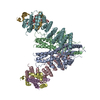
|
|---|---|
| 1 |
|
- Components
Components
-Protein , 4 types, 8 molecules ABCFDGEH
| #1: Protein | Mass: 38574.414 Da / Num. of mol.: 2 / Mutation: D68N Source method: isolated from a genetically manipulated source Source: (gene. exp.)   References: UniProt: Q6IQE5, Hydrolases; Acting on acid anhydrides #2: Protein | Mass: 37054.695 Da / Num. of mol.: 2 Source method: isolated from a genetically manipulated source Source: (gene. exp.)  Homo sapiens (human) / Gene: GET4, C7orf20, CEE, TRC35, CGI-20 / Production host: Homo sapiens (human) / Gene: GET4, C7orf20, CEE, TRC35, CGI-20 / Production host:  #3: Protein | Mass: 14618.276 Da / Num. of mol.: 2 Source method: isolated from a genetically manipulated source Source: (gene. exp.)  Homo sapiens (human) / Gene: BAG6, BAT3, G3 / Production host: Homo sapiens (human) / Gene: BAG6, BAT3, G3 / Production host:  #4: Protein | Mass: 18741.480 Da / Num. of mol.: 2 Source method: isolated from a genetically manipulated source Source: (gene. exp.)  Homo sapiens (human) / Gene: UBL4A, DXS254E, GDX, UBL4 / Production host: Homo sapiens (human) / Gene: UBL4A, DXS254E, GDX, UBL4 / Production host:  |
|---|
-Non-polymers , 3 types, 5 molecules 




| #5: Chemical | | #6: Chemical | #7: Chemical | ChemComp-ZN / | |
|---|
-Details
| Has ligand of interest | N |
|---|
-Experimental details
-Experiment
| Experiment | Method: ELECTRON MICROSCOPY |
|---|---|
| EM experiment | Aggregation state: PARTICLE / 3D reconstruction method: single particle reconstruction |
- Sample preparation
Sample preparation
| Component | Name: metazoan pre-targeting GET complex cBUGG-out / Type: COMPLEX / Entity ID: #1-#4 / Source: MULTIPLE SOURCES | ||||||||||||
|---|---|---|---|---|---|---|---|---|---|---|---|---|---|
| Molecular weight | Experimental value: YES | ||||||||||||
| Source (natural) |
| ||||||||||||
| Source (recombinant) | Organism:  | ||||||||||||
| Buffer solution | pH: 7.5 | ||||||||||||
| Specimen | Embedding applied: NO / Shadowing applied: NO / Staining applied: NO / Vitrification applied: YES | ||||||||||||
| Vitrification | Cryogen name: ETHANE |
- Electron microscopy imaging
Electron microscopy imaging
| Experimental equipment |  Model: Titan Krios / Image courtesy: FEI Company |
|---|---|
| Microscopy | Model: FEI TITAN KRIOS |
| Electron gun | Electron source:  FIELD EMISSION GUN / Accelerating voltage: 300 kV / Illumination mode: FLOOD BEAM FIELD EMISSION GUN / Accelerating voltage: 300 kV / Illumination mode: FLOOD BEAM |
| Electron lens | Mode: BRIGHT FIELD |
| Image recording | Electron dose: 54 e/Å2 / Film or detector model: GATAN K3 (6k x 4k) |
- Processing
Processing
| CTF correction | Type: PHASE FLIPPING AND AMPLITUDE CORRECTION |
|---|---|
| Symmetry | Point symmetry: C2 (2 fold cyclic) |
| 3D reconstruction | Resolution: 3.4 Å / Resolution method: FSC 0.143 CUT-OFF / Num. of particles: 35535 / Symmetry type: POINT |
 Movie
Movie Controller
Controller








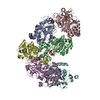
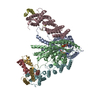
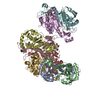
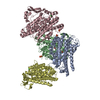
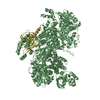
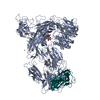

 PDBj
PDBj






